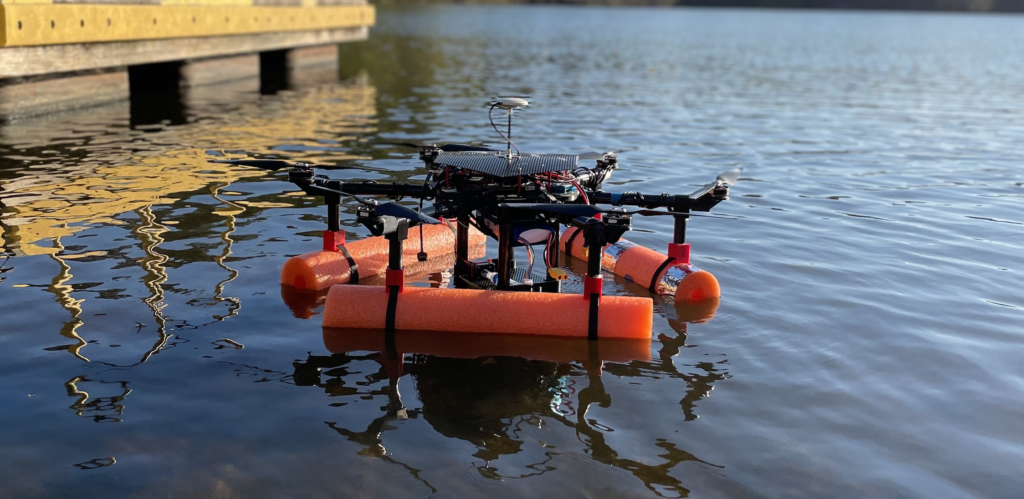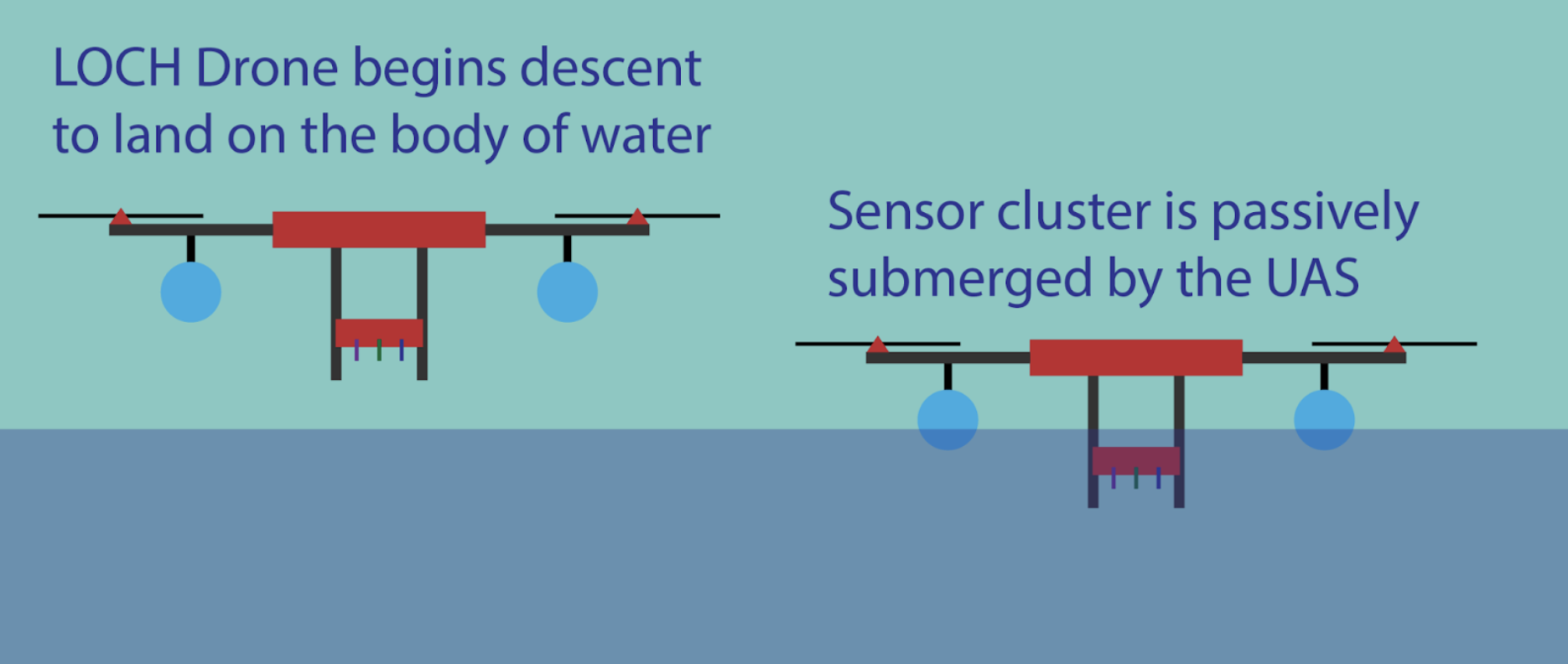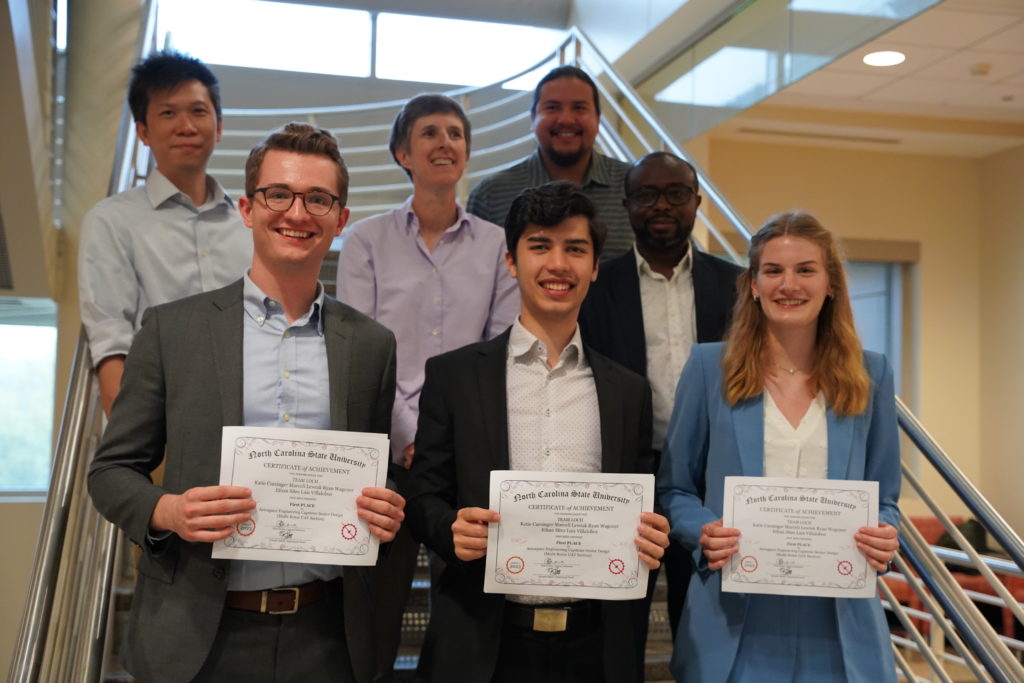
A drone fully capable of landing on the water to collect data on endangered fish populations and map underwater reservoirs to track erosion.
The drone, designed to be fully waterproof, will aid the US Forest Service in their aquatic missions to make data collection more convenient and accessible.
Final report accessible here
We are a group of five students who came together for the Aerospace Engineering Senior Design at NC State. Together, we named ourselves Team L.O.C.H: Locate, Observe, Collect, and Hover. Each team member is responsible for the development of their own subsystem. My technical responsibility was flight controls and software. On top of this, I was elected the Project Manager, which is in charge of the workflow and communicates directly with the customers.

Flight Controls is heavily focused on maintaining the stability of the drone in flight. This feat seems quite simple: keep the drone loitering. The challenge of this is any disturbances in the surroundings, whether it be wind, wind shear, or turbulence. Additional internal disturbances can make this challenging, such as low voltages or a faulty motor. Recognizing these problems in advance and intentionally programming for redundancy is what makes aviation so profoundly characteristic. Every aircraft has its own set of emergency procedures, often meticulously practiced and repeated since every second matters in emergencies. Thus, a strong emphasis will be put on emergencies in my tests, particularly aiming for recoveries in a timely manner.
Over the coming months, we will be developing a fully waterproof drone which will assist the US Forest Service in their aquatic missions for unmanned aircraft. This includes the following two missions:


Seen above in the two graphics is our concept of operations. In the Fall semester, the team developed the concept, along with the full part list required to make the mission feasible and possible. A validation, verification, and testing plan was also developed by each subsystem lead individually to ensure that the mission profile can be safely completed.

As the Flight Controls and Software Engineer, my job is to ensure the safety control of the drone during flight, especially in critical moments of flight (TOLs on land, TOLs on the water). It is my responsibility to include various automated emergency procedures, such as a max-altitude flight level that cannot be surpassed to comply with FAA regulations. And lastly, I am tasked with implementing Remote Identification broadcasting, which is a new FAA requirement to come in the Fall of 2023.
Since Remote ID is a new requirement for unmanned vehicle, there are no little to no resources available on implementation and verification. Thanks to DroneTag, an overseas manufacturer specializing in Remote ID Broadcasting, the team was able to purchase a Remote ID Module that transmits data.
For my subsystem, I conducted a test known as the attitude-stabilization test. This test demonstrates that the motors are functional, working in tandem with the flight controller, and ensure the appropriate orientation and functionality of the flight controller. The self-stabilization feature is a sophisticated process that ensures proper functionality of all of these components. The test is done in an “iron bird” manner, where the propellers are not mounted onto the motors so that it does not take off. Overall, the drone successfully reacted appropriately to the disturbances. The motors angled downward increased their RPMS in efforts to stabilize the attitude of the drone. The motors which were raised upwards slightly reduced their RPMs. RPMs were measured with a tachometer. Overall, the motors which were angled downward saw approximately a 20% increase in RPM, while the motors in the air upward saw a 5% decrease in RPM.
Once all verification testing was complete, the team conducted a flight test to ensure that all subsystems were working together as intended. The first flight test was conducted over land just to ensure basic flight was capable. Once the drone showed sophisticated flight, the team conducted another flight test, this time on the water. All flight tests were incredibly successful; The water-flight test is shown in the youtube video above.

Overall, I believe that I have grown a lot throughout this senior design project, especially as a project manager. The team held its symposium and were declared first-place winners for the Aerospace Engineering Capstone Senior Design for the Multi-rotor section. As a project manager, I believe that I helped the team stay on task throughout the semester with no incidents or major disagreements. Of course there are moments of discussion and brainstorming in the design process, where ideas are argued and dismissed, but we did so with no lasting hatred or animosity. From a technical standpoint, I believe that this course sharpened my knowledge of industry standards for aerospace. I discovered that full-fledged engineers go through the same exact process for prototyping, so I was incredibly happy to step up and do the same. The challenging part of this course was the expedited nature of prototyping, especially when done so in a small team. In the first semester, there were moments where each week was a new major deliverable, and this put our work ethic to the test. Due to this, I believe that my technical writing abilities have improved, along with my presentation skills. I am incredibly proud of my team and what we have accomplished in our year of senior design.
